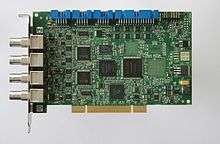Matrox
Matrox is a producer of video card components and equipment for personal computers and workstations. Based in Dorval, Quebec, Canada, it was founded in 1976 by Lorne Trottier and Branko Matić. The name is derived from "Ma" in Matić and "Tro" in Trottier.[2]
 | |
| Private | |
| Industry | Computer hardware |
| Founded | 1976 |
| Founders | Lorne Trottier Branko Matić |
| Headquarters | , Canada |
| Products | Video cards |
Number of employees | 700 (2019)[1] |
| Website | www |
Company
Matrox is an umbrella name for the following legal entities:
- Matrox Electronic Systems Ltd., a company comprising three divisions.[3]
- Matrox Graphics Inc., the entity most recognized by the public which has been making graphics cards for over 30 years.
- Matrox Imaging, which produces frame grabbers, smart cameras and image processing/analysis software.
- Matrox Video Products Group, which produces video-editing products for professional video production and broadcast markets.
History
Matrox's first graphics card product was the ALT-256 for S-100 bus computers, released in 1978. The ALT-256 produced a 256 by 256 pixel monochrome display using an 8 kilobyte (64 kilobit) frame buffer consisting of 16 TMS4027 DRAM chips (4 kilobits each). An expanded version followed, the ALT-512, both available for Intel SBC bus machines as well. Through the 1980s, Matrox's cards followed changes in the hardware side of the market, to Multibus and then the variety of PC standards.
.png)
During the 1990s, the Matrox Millennium series of cards attracted buyers willing to pay for a higher quality and sharper display. In 1994 Matrox introduced the Matrox Impression, an add-on card that worked in conjunction with a Millennium card to provide 3D acceleration. The Impression was aimed primarily at the CAD market. A later version of the Millennium included features similar to the Impression but by this time the series was lagging behind emerging vendors like 3dfx Interactive.
Matrox made several attempts to increase its share of the market for 3D-capable cards. The Matrox Mystique, released in 1996, was the company's first attempt to make a card with good gaming performance and with pricing suitable for that market. The product had good 2D and 3D performance but produced poor 3D images with the result that it was derided in reviews, being compared unfavorably with the Voodoo1 and even being nicknamed the "Matrox Mystake".[4][5][6][7][8][9]

Another attempt was the Matrox G100 and G200. The G200 was sold as two models, the Millennium G200 was a higher-end version typically equipped with 8 MB SGRAM memory, while the Mystique G200 used slower SDRAM memory but added a TV-out port. The G200 offered competent 3D performance for the first time, but was released shortly before a new generation of cards from Nvidia and ATI which completely outperformed it. Later versions in the Matrox G400 series were never able to regain the crown, and despite huge claims for the Matrox Parhelia, their performance continued to be quickly outpaced by the major players.
Since then, Matrox has continued to shift the focus of its card designs towards specialized, niche markets, moving more deeply into enterprise, industrial, and government applications. This includes solutions for when a large amount of monitors attached to the same PC is required. In recent years they have held no more than a 3–5% share of the total video card market. Matrox is now divided in three divisions: Matrox Graphics, Matrox Video, and Matrox Imaging. Matrox Graphics is the primary consumer and end-user brand, while Matrox Video markets digital video editing solutions, and Matrox Imaging sells high-end video capture systems and "smart cameras", video cameras with a built-in computer for machine vision applications.
On September 6, 2019, the company announced that its co-founder Lorne Trottier had acquired 100% ownership of the Matrox group of companies, including its three divisions—Matrox Imaging, Matrox Graphics, and Matrox Video.[1]
Driver support
To support Unix and Linux, Matrox has released only binary drivers for most of their product line and one partially free and open-source driver for the G550 card which comes with a binary blob to enable some additional functionality. These drivers were tested and are allegedly supported for quite old distributions.[10] They do not work on newer Linux kernels and X.Org Server versions. In addition to the proprietary drivers provided by Matrox, the DRI community has provided drivers under the GPL license for many more of the devices.
See also
- Computer graphics
- Graphics chip
- Graphics processing unit
- Matrox RT.X100
- Matrox Graphics eXpansion Modules
Similar companies
References
- "Lorne Trottier Acquires Full Ownership of Matrox, to Lead New Era of Tech Innovation". Matrox. 2019-09-06. Retrieved 2019-09-10.
- Marotte, Bertrand (2000-11-01). "Engineer makes philanthropic connection". Retrieved 2019-09-10.
- "Company Overview". Matrox. Retrieved 2019-09-10.
- "Hattix Hardware".
- "what 3Dfx chip was used in Sega's 'Black Belt' prototype c.. - Graphics Cards".
- "Archived copy". Archived from the original on 2010-07-16. Retrieved 2010-02-02.CS1 maint: archived copy as title (link)
- "Tell me about your video card(s) - Ars Technica OpenForum".
- "what 3Dfx chip was used in Sega's 'Black Belt' prototype console ? - Motherboard Forums".
- http://forum.pcvsconsole.com/viewthread.php?tid=1007&page=3
- ftp://ftp.matrox.com/pub/mga/archive/linux/2009/1.4.7/readme.txt
External links
| Wikimedia Commons has media related to Matrox. |